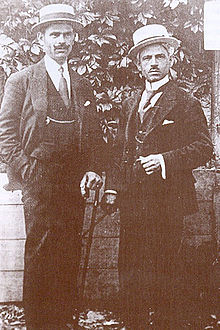Yanaki and Milton Manaki
The brothers Yanaki ( Greek Ιωάννης «Γιαννάκης» , * 1878 in Avdella , Greece ; † 1954 in Thessaloniki ) and Milton Manaki ( Greek Μιλτιάδης «Μίλτος» Μανάκη , * September 9, 1882 in Avdella; † March 5, 1964 ) were in Bitola two photo and film pioneers who made the first films on the Balkan Peninsula and in the Ottoman Empire . Her film career began in 1905 with the 60-second documentary Die Weberinnen , which shows her grandmother spinning and weaving and is considered one of the first films to be recorded in Southeastern Europe. The Manaki Brothers used an imported from Yanaki from London for their work 35mm - Urban Bioscope camera.
photography
In 1904 the two Aromanian brothers moved from their place of birth Avdella to Monastir (today Bitola , North Macedonia ), the economic and cultural center of the Ottoman province of Rumelia , where they opened a photo studio a year later . After their work became known, they received an invitation from King Charles I of Romania in 1906 to take part in the Bucharest Jubilee Exhibition , where they won a gold medal . They later became official photographers of the Ottoman Sultan and, in 1929, of the Yugoslav King Alexander I.
Movie
According to Milton Manaki's memoirs, his older brother toured various European capitals in 1905. In London he purchased a Bioscope 300 film camera from the Charles Urban Trading Company , which the brothers used to film their 114-year-old grandmother Despina weaving . This recording is considered to be one of the earliest films in Southeast Europe and was made just 10 years after the first film by the Lumière brothers , who had a great influence on the Manaki brothers.
After that, Yanaki and Milton made many other films, mainly documentaries , showing the simple life of the northern and eastern provinces of what is now Greece, such as folk dances , religious festivals, weddings and funerals . In addition to their work as filmmakers and photographers, they opened an open-air cinema in Bitola in 1921 , which was later converted into a luxurious movie theater and burned down in 1939.
estate
The National Archives of the Republic of Macedonia holds more than 17,000 photos and over 2,000 meters of footage of the Manaki brothers. The collection has an important documentary value for the historical and cultural development of Southeast Europe. In honor of the two brothers, the Manaki Brothers Film Festival is held in Bitola every year .
gallery
Gold medal certificate for the Manaki brothers issued by King Charles of Romania .
See also
literature
- Distinguished people for Bitola. NUUB St. Clement of Ohrid, Bitola 2007, ISBN 978-9989-2783-0-3 , pp. 123-126.
- Elene Psoma: Filmland Greece - Terra incognita. Dissertation, Logos, Berlin 2008, ISBN 3-8325-1618-2 , pp. 21-26.
Web links
- Yanaki Manaki in the Internet Movie Database (English)
- Milton Manaki in the Internet Movie Database (English)
- Јанаки Манаки (Македонски легенди) (Macedonian)
- Милтон Манаки (Македонски легенди) (Macedonian)
Individual evidence
- ↑ Milton Manaki in the Internet Movie Database (English)
- ↑ Elene Psoma: Filmland Greece , 2008, p. 21.
- ↑ Elene Psoma: Filmland Greece , 2008, p. 23.
- ↑ Dimitar Bechev: Historical Dictionary of the Republic of Macedonia. (= Historical Dictionaries of Europe , No. 68.), Scarecrow Press, 2009, ISBN 0-8108-6295-6 , p. 234.
- ↑ Distinguished people for Bitola , 2007, p. 123.
- ↑ Милтон Манаки. In: mn.mk. December 7, 2011, accessed January 25, 2016 .
- ↑ Томислав Османли: ПО ПОВОД МАНАКИ . Skopje 2006, p. 27.
- ↑ Elene Psoma: Filmland Greece , 2008, p. 22.
- ↑ Elene Psoma: Filmland Greece , 2008, p. 23.
- ↑ Distinguished people for Bitola , 2007, p. 126.
- ↑ Elene Psoma: Filmland Greece , 2008, pp. 24-25
- ↑ Igor Stardelov: Preservation of Manaki Brothers film heritage. In: Journal of Film Preservation , Volume XXVI N ° 54, April 1997 ( http://www.fiafnet.org/pdf/uk/fiaf54.pdf ( Memento of November 26, 2013 in the Internet Archive ) )





